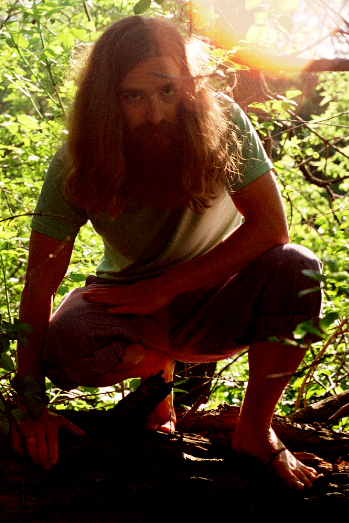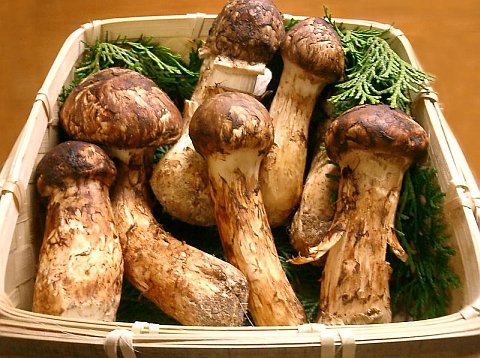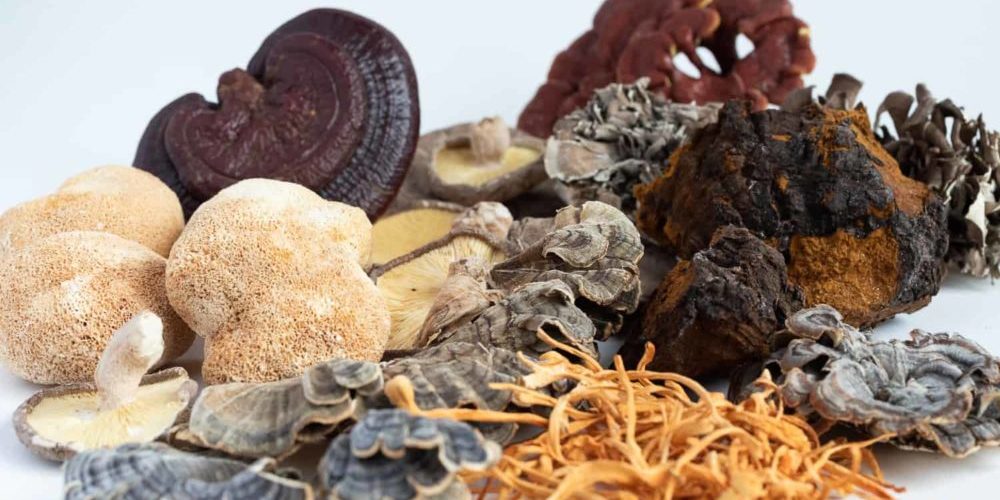What is the Matsutake Mushroom?
In the Japanese culture, the matsutake has long been prized for its flavour and distinct taste. A decade ago, the world market was estimated at US$300 million and retail prices were known to reach US$1250/kg (Yun et al., 1997) which makes it one of the most expensive mushrooms in the world. In Japan – the major market for fresh matsutake – native supply has dwindled and most matsutake is imported, although demand still outstrips supply (Amaranthus et al., 2000). Most of Japan’s supply comes from China, North and South Korea, Canada, the USA, Morocco and Taiwan (Yun et al., 1997). Because of the importance of maintaining mushroom quality during the shipping process, some research has been done on determining the effect of varying CO2 and O2 concentrations on mushroom quality during storage. The optimum storage conditions were a low O2 concentration (2.5%) with 5%-10% CO2 concentration, approximately 100% relative humidity and a temperature of 1°C (Kaji et al., 1993)
In Korea, T. matsutake sold for the market are classified according to their appearance, in a scheme developed by the National Forestry Cooperatives Federation:
1st grade: highest quality, over 8 cm long with an unopened pileus.
2nd grade: generally 6–8 cm long, but their widths are irregular and their pilei are not opened.
3rd grade: less than 6 cm long or have one-third opened pilei
4th grade: completely opened pilei.
A method has been developed to discriminate between the different grades of Matsutake using metabolomic analysis with proton-NMR and principal component analysis (Cho et al., 2007). The authors demonstrate that the metabolites choline, trehalose, threonine, leucine/isoleucine, succinic acid, alanine, fumaric acid are the components that allow for the discrimination of different grades of raw matsutake.
T. matsutake forms a solid, tight white aggregate of mycelia and mycorrhizas below the litter layer called a “shiro”, which in Japanese means white color, castle or place (Peter, 2006).
The pine mushroom, Tricholoma Matsutake (S. Ito & S.Imai) Singer
Basionym
Armillaria matsutake S. Ito & S. Imai 1925
Synonyms
Morphological studies (Kytövuori, 1988) suggested, and DNA sequencing analysis has confirmed (Bergius and Danell, 2000) that the so-called “Swedish matsutake”, Tricholoma nauseosum, is the same species as T. matsutake. That being the case, the following synonyms for the former apply to the latter:
Tricholoma nauseosum (A. Blytt) Kytovuori
Armillaria nauseosa A. Blytt
Tricholoma caligatum var. nauseosum (A. Blytt) Bon
The common name matsutake is also sometimes used to refer to the species T. caligatum (Viv.) Rick. and the American species T. magnivelare (Peck) Redhead. Other related species include T. bakamatsutake, T. quercicola, T. fulvocastaneum and T. robustum (Yun et al., 1997).
Common names
Matsutake
Pine mushroom
Bioactive compounds
A number of sterols have been isolated from T. matsutake (Ohnuma et al., 2000):
– (22E)-23-methylergosta-5,7,22-triene-3β-ol
– 5α,6α-epoxy-(22E)-ergosta-8,14,22-triene-3β,7α-diol
– 5α,8α-epoxy-(22E)-ergosta-6,22-diene-3β-ol
– 5α,6α-epoxy-(22E)-ergosta-8(14),22-diiene-3β,7α-diol
– 5α,6α:8α,9α-diepoxy-(22E)-ergost-22-ene-3β,7α-diol
– 3β,5α-dihydroxy-(22E)-ergosta-7,22-diene-6-one
– 3β,5α,9α-trihydroxy-(22E)-ergosta-7,22-diene-6-one
– 3β,5α,9α-trihydroxyergost-7-ene-6-one
– 3β,5α,9α,14α-tetrahydroxy-(22E)-ergosta-7,22-diene-6-one
– (22E)-ergosta-7,22-diene-3β,5α,6β-triol
– ergost-7-ene-3β,5α,6β-triol
– (22E)-ergosta-7,22-diene-3b,5α,6α,9α-tetrol
– (22E)-ergosta-7,22-diene-3β,5α,6β,9α-tetrol
Shortly after, Yaoita et al. (2001) added a couple more to the list:
– 5α,9α-epidioxy-(22E)-ergosta-7,22-dien-3β,6β-diol
– 3β,5α,9α,14β-tetrahydroxy-(22E)-ergosta-7,22-dien-6-one

My name is Austin Collins.
I've dedicated my life to Mushrooms.
I believe Mushrooms are the best kept secret when it comes to health and well being.
For that reason, I would like to share a company with you that in my opinion makes the best mushroom products on the market.
The company is called Noomadic Herbals, my favorite supplement they make is called "Mushroom Total".
I take their products every day and they have helped me think better and have more energy. Give them a try.
-Austin
Matsutake Mushroom Benefits & Medicinal Properties
Antioxidant/Free-Radical Scavenging Activity/Antiinflammatory
A recent study examined the free radical-scavenging ability (FRSA) and inhibition of nitric oxide (NO) production by various solvent extracts obtained from four grades of pine mushroom (Lim et al., 2007). It was found that extracts from first-grade pine mushrooms had greater FRSA than the other grades, which showed sequentially lower FRSA according to the grade of mushroom; inhibition of NO production showed a similar trend. At a concentration of 2 g/L of extract, the FRSA, which ranged from 30.5% (water fraction) to 60.1% (ethyl acetate fraction), compares favorably to some other medicinal mushroom species, such as Grifola frondosa, Morchella esculenta and Termitomyces albuminosus. Furthermore, the ethyl acetate and butanol fractions (fractions which had the highest levels of phenolics and flavonoids) both substantially inhibited nitric oxide production and suggests that matsutake extract may show promise as an anti-inflammatory agent.
Anti-fat
The increase of fat mass associated with obesity is due in part to an increase in the number of fat cells, or adipocytes. This increase in the number of fat cells (hyperplasia) results from recruitment of pluripotent stem cells present in the vascular stroma of adipose tissue. A model cell culture system, using C3H10T1/2 stem cells, has been developed that models this process. T. matsutake was one of several mushrooms (the others were Lentinus edodes, Lyophyllum shimeji, Flammulina velutipes and Grifola frondosa) that demonstrated an heat-labile ability to inhibit the conversion of C3H10T1/2 into adipocytes (Ohtsuru et al., 2000).
Anti-tumor
Matsutake was shown to have anti-tumor activity back in 1969 (Ikekawa et al., 1969). A mycelial preparation of this mushroom prepared in bulk culture was shown to have antitumor activity against the in vivo growth of mouse syngeneic fibrosarcoma (Ebina et al., 2002) as well as preventive activity against the formation of azoxymethane-induced precancerous lesions in the colon (Matsunaga et al., 2003).
Links
http://www.sporelab.com/pine.html
Matsiman.com
Mushroom Expert
Fantastic Forage: Wild matsutake mushrooms – by Hsiao-Ching Chou, Seattle Post-Intelligencer
Tom Volk’s Fungus of the Month, September 2000 discusses the American matsutake
References
Amaranthus MP, Pilz D, Moore A, Abbott R, Luoma D.
American Matsutake (Tricholoma magnivelare) across Spatial and Temporal Scales.
pp 99-108.
(in: Powers RF, Hauxwell DL, Nakamura GM (technical coordinators). 2000. Proceedings of the California Forest Soils Council conference on forest soils biology and forest management; February 23-24, 1996; Sacramento, California. Gen. Tech. Rep. PSW-GTR-178. Albany, CA: Pacific Southwest Research Station, Forest Service, U.S. Department of Agriculture; 113 p.)
Bergius N, Danell E.
The Swedish matsutake (Tricholoma nauseosum syn. T. matsutake): distribution, abundance and ecology.
Scand J Forest Res. 2000 15(3):318-25.
Cho IH, Choi HK, Kim YS.
Difference in the volatile composition of pine-mushrooms (Tricholoma matsutake Sing.) according to their grades.
J Agric Food Chem. 2006 54(13):4820-5.
Cho IH, Kim SY, Choi HK, Kim YS.
Characterization of aroma-active compounds in raw and cooked pine-mushrooms (Tricholoma matsutake Sing.).
J Agric Food Chem. 2006 54(17):6332-5.
Cho IH, Kim SY, Lee SM, Choi HK, Kim KO, Kim YS.
Characterization of the overall flavor profiles and odor-active compounds in pine-mushrooms (Tricholoma matsutake Sing.) of different grades.
Abstracts of Papers of the American Chemical Society. 2005 230:U52-U3.
Cho IH, Kim YS, Choi HK.
Metabolomic discrimination of different grades of pine-mushroom (Tricholoma matsutake Sing.) using 1H NMR spectrometry and multivariate data analysis.
J Pharm Biomed Anal. 2007 43(3):900-4.
Cho IH, Kim YS, Lee KW, Choi HK.
Determination of differences in the nonvolatile metabolites of pine-mushrooms (Tricholoma matsutake sing.) according to different parts and heating times using 1H NMR and principal component analysis.
J Microbiol Biotechnol. 2007 17(10):1682-7.
Cho IH, Lee SM, Kim SY, Choi HK, Kim KO, Kim YS.
Differentiation of aroma characteristics of pine-mushrooms (Tricholoma matsutake Sing.) of different grades using gas chromatography-olfactometry and sensory analysis.
J Agric Food Chem. 2007 55(6):2323-8.
Cho IH, Namgung HJ, Choi HK, Kim YS.
Volatiles and key odorants in the pileus and stipe of pine-mushroom (Tricholoma matsutake Sing.).
Food Chem. 2008 106(1):71-6.
Ebina T, Kubota T, Ogamo N, Matsunaga K.
Antitumor effect of a peptide-glucan preparation extracted from a mycelium of Tricholoma matsutake (S. Ito and Imai) Sing.
Biother. 2002, 16, 255-259.
Guerin-Laguette A, Matsushita N, Lapeyrie F, Shindo K, Suzuki K.
Successful inoculation of mature pine with Tricholoma matsutake.
Mycorrhiza. 2005 15(4):301-5.
Guerin-Laguette A, Shindo K, Matsushita N, Suzuki K, Lapeyrie F.
The mycorrhizal fungus Tricholoma matsutake stimulates Pinus densiflora seedling growth in vitro.
Mycorrhiza. 2004 14(6):397-400.
Hoshi H, Yagi Y, Iijima H, Matsunaga K, Ishihara Y, Yasuhara T.
Isolation and characterization of a novel immunomodulatory α-glucan-protein complex from the mycelium of Tricholoma matsutake in basidiomycetes.
J Agric Food Chem. 2005 53(23):8948-56.
Hoshi H, Yagi Y, Matsunaga K, Ishihara Y, Yasuhara T.
Development of an enzyme-linked immunosorbent assay to detect an immunomodulatory α-D-glucan-protein complex, MPG-1, in basidiomycete Tricholoma matsutake and related processed foods.
J Agric Food Chem. 2007 55(21):8508-15.
Ikekawa T, Uehara N, Maeda Y, Nakanishi M, Fukuoka F.
Antitumor activity of aqueous extracts of edible mushrooms.
Cancer Res. 1969 29:734-9.
Inaba K, Yoshida T, Mitsunaga T, Koshijima T.
Acceleration of the growth of Tricholoma matsutake mycelium by a fraction of sulfite pulping waste.
Mokuzai Gakkaishi. 1993 39(6):710-5.
Ishihara Y, Iijima H, Yagi Y, Hoshi H, Matsunaga K.
Inhibition of decrease in natural killer cell activity in repeatedly restraint-stressed mice by a biological response modifier derived from cultured mycelia of the basidiomycete Tricholoma matsutake.
Neuroimmunomodulation. 2004 11(1):41-8.
Ishihara Y, Iijima H, Yagi Y, Matsunaga K.
Enhanced recovery of NK cell activity in mice under restraint stress by the administration of a biological response modifier derived from the mycelia of the basidiomycete Tricholoma matsutake.
Stress-Int J Biol Stress. 2003 6(2):141-8.
Iwase, K.
Cultivation of mycorrhizal mushrooms.
Food Reviews International. 1997 13(3):431-42.
Kaji H, Ueno M, Ikebe T, Osajima Y.
Effects of low O2 and elevated CO2 concentrations on the quality of Matsutake [Tricholoma matsutake (S Ito Et Imai) Sing] during storage.
Bioscience Biotechnology and Biochemistry. 1993 57(3):363-6.
Kawagishi H, Hamajima K, Takanami R, Nakamura T, Sato Y, Akiyama Y, Sano M, Tanaka O.
Growth promotion of mycelia of the Matsutake mushroom Tricholoma matsutake by D-isoleucine.
Biosci Biotechnol Biochem. 2004 68(11):2405-7.
Kawagoe M, Kawakami K, Nakamura Y, Naoe K, Miki K, Noda H.
Submerged culture of Tricholoma matsutake mycelium in bubble column fermentors.
Journal of Bioscience and Bioengineering. 1999 87(1):116-8.
Kawai M, Ogawa M.
Studies on artificial reproduction of Tricholoma matsutake (S-Ito-Et-Imai) Sing .4. Studies on a seed culture and a trial for cultivation on solid media.
Transactions of the Mycological Society of Japan. 1976 17(3-4):499-505.
Kawai M, Ogawa M.
Studies on artificial reproduction of Tricholoma matsutake (S-Ito Et Imai) Sing .5. Effects of some chemicals on growth of mycorrhizal and non-mycorrhizal soil fungi.
Transactions of the Mycological Society of Japan. 1977 18(4):391-8.
Kawai, M, Ogawa, M.
Studies on artificial reproduction of Tricholoma matsutake (S Ito Et Imai) Sing .6. Effects of Tbz, benlate, paraquat and some other chemicals on soil microbe populations and on growth of Pinus densiflora seedlings.
Transactions of the Mycological Society of Japan. 1978 19(1):1-9.
Kytövuori I.
The Tricholoma caligatum group in Europe and North Africa.
Karstenia.1988 28:65-77.
Lee HJ Choi YJ, Ka KH, Park WC.
Chemical constituents from the fruit bodies of Tricholoma matsutake.
Mokchae Konghak. 2003 31:63–70.
Lian CL, Narimatsu M, Nara K, Hogetsu T.
Tricholoma matsutake in a natural Pinus densiflora forest: correspondence between above- and below-ground genets, association with multiple host trees and alteration of existing ectomycorrhizal communities.
New Phytologist. 2006 171(4):825-36.
Lim HW, Yoon JH, Kim YS, Lee MW, Park SY, Choi HK.
Free radical-scavenging and inhibition of nitric oxide production by four grades of pine mushroom (Tricholoma matsutake Sing.).
Food Chem. 2007 103(4):1337-42.
Matsunaga K, Chiba T, Takahashi E.
Mass production of Matsutake (Tricholoma matsutake) mycelia and its application to functional foods.
Bioindustry 2003, 20, 37-46.
Mau JL, Lin HC, Song SF.
Antioxidant properties of several specialty mushrooms.
Food Res Int. 2002 35(6):519-26.
Morinaga T.
Effects of pH on spore germination of Tricholoma matsutake.
Journal of the Agricultural Chemical Society of Japan. 1985 59(8):807-9.
Ogawa M.
Microbial ecology of shiro in Tricholoma matsutake (S-Ito Et Imai) Sing and its allied Species .4. Tricholoma matsutake in Tsuga-Diversifolia forests.
Trans Myco Soc Jap. 1977 18(1):20-33.
Ogawa M.
Microbial ecology of shiro in Tricholoma matsutake (S-Ito Et Imai) Sing and its allied species .5. Tricholoma matsutake in Tsuga-Sieboldii forests.
Trans Myco Soc Jap. 1977 18(1):34-46.
Ogawa M, Ito T, Kobayashi F, Fujita H.
On the primary stage in Shiro formation of Tricholoma matsutake.
Trans Myco Soc Jap. 1980 21(4):505-12.
Ohara H.
Antibacterial activity of mycorrhiza of Pinus Densiflora formed by Tricholoma matsutake.
Proceedings of the Japan Academy. 1966 42(5):503-&.
Ohara H, Hamada M.
Disappearance of bacteria from zone of active mycorrhizas in Tricholoma matsutake (S Ito Et Imai) Singer.
Nature. 1967 213(5075):528-&.
Ohnuma N, Amemiya K, Kakuda R, Yaoita Y, Machida K, Kikuchi M.
Sterol constituents from two edible mushrooms, Lentinula edodes and Tricholoma matsutake.
Chem Pharm Bull. 2000 48(5):749-51.
Ohta A.
Quantitative analysis of odorous compounds in the fruit bodies of Tricholoma matsutake.
Trans Myco Soc Japan. 1983 24(2):185-90.
Ohta A.
Basidiospore germination of Tricholoma matsutake .1. Effects of organic acids on swelling and germination of the basidiospores.
Transactions of the Mycological Society of Japan. 1986 27(2):167-73.
Ohta A.
Basidiospore germination of Tricholoma matsutake .2. Evaluations of germination conditions and microscopic observations of germination stages.
Trans Myco Soc Jap. 1986 27(4):473-80.
Ohtsuru M, Horio H, Masui H.
Screening of various mushrooms with inhibitory activity of adipocyte conversion.
J Jap Soc Food Sci Technol-Nippon Shokuhin Kagaku Kogaku Kaishi. 2000 47(5):394-6.
Peter M.
Ectomycorrhizal fungi – fairy rings and the wood-wide web.
New Phytol. 2006 171(4):685-7.
Richards RT, Creasy M.
Ethnic diversity, resource values, and ecosystem management: Matsutake mushroom harvesting in the Klamath bioregion.
Soc Nat Res. 1996 9(4):359-74.
Sha T, Zhang HB, Ding HS, Li ZJ, Cheng LZ, Zhao ZW, Zhang YP.
Genetic diversity of Tricholoma matsutake in Yunnan Province.
Chin Sci Bull. 2007 52(9):1212-6.
Takakura Y, Kuwata S.
Purification, characterization, and molecular cloning of a pyranose oxidase from the fruit body of the basidiomycete, Tricholoma matsutake.
Biosci Biotechnol Biochem. 2003 67(12):2598-607.
Takama F, Ishii H, Muraki S.
Flavor components in Japanese and Korean matsutake Tricholoma matsutake (Ito,S. Et Imai) Sing – and their change during storage.
J Jap Soc Food Sc Technol-Nippon Shokuhin Kagaku Kogaku Kaishi. 1984 31(1):14-8.
Terashita, T, Kono, M.
Purification and some properties of carboxyl proteinases from Tricholoma matsutake.
Trans Myco Soc Jap. 1987 28(3):245-56.
Tsuruta, T, Kawai, M.
Studies on the artificial reproduction of Tricholoma matsutake (S Ito Et Imai) Sing .7. Antibiotic activities of volatile substances extracted from a shiro of Tricholoma matsutake.
Trans Myco Soc Jap. 1979 20(2):211-9.
Vaario LM, Gill WM, Samejima M, Suzuki K.
Detection of the ability of Tricholoma matsutake to utilize sawdust in aseptic culture.
Symbiosis. 2003 34(1):43-52.
Vaario LM, Guerin-Laguette A, Matsushita N, Suzuki K, Lapeyrie F.
Saprobic potential of Tricholoma matsutake: growth over pine bark treated with surfactants.
Mycorrhiza. 2002 12(1):1-5.
Wood, WF, Lefevre, CK.
Changing volatile compounds from mycelium and sporocarp of American matsutake mushroom, Tricholoma magnivelare.
Biochemical Systematics and Ecology. 2007 35(9):634-6.
Yamada, A, Maeda, K, Kobayashi, H, Murata, H.
Ectomycorrhizal symbiosis in vitro between Tricholoma matsutake and Pinus densiflora seedlings that resembles naturally occurring ‘shiro’.
Mycorrhiza. 2006 16(2):111-6.
Yamada A, Ogura T, Ohmasa M.
Cultivation of mushrooms of edible ectomycorrhizal fungi associated with Pinus densiflora by in vitro mycorrhizal synthesis II. Morphology of mycorrhizas in open-pot soil.
Mycorrhiza. 2001 11(2):67-81.
Yaoita Y, Matsuki K, Iijima T, Nakano S, Kakuda R, Machida K, Kikuchi M.
New sterols and triterpenoids from four edible mushrooms.
Chem Pharm Bull. 2001 49(5):589-94.
Yokoyama K.
Shiitake (Lentinula edodes), Matsutake (Tricholoma matsutake) etc, painted by Watanabe, Kazan in the 1840s, the Edo period.
Transactions of the Mycological Society of Japan. 1985 26(1):105-8.
Yokoyama R, Yamada T.
In vitro cultures of Tricholoma matsutake and Pinus densiflora.
Transactions of the Mycological Society of Japan. 1987 28(3):331-8.
Yun W, Hall IR.
Edible ectomycorrhizal mushrooms: challenges and achievements.
Can J Bot. 2004 82(8):1063-73.
Yun W, Hall IR, Evans LA.
Ectomycorrhizal fungi with edible fruiting bodies .1. Tricholoma matsutake and related fungi.
Economic Botany. 1997 51(3):311-27.


